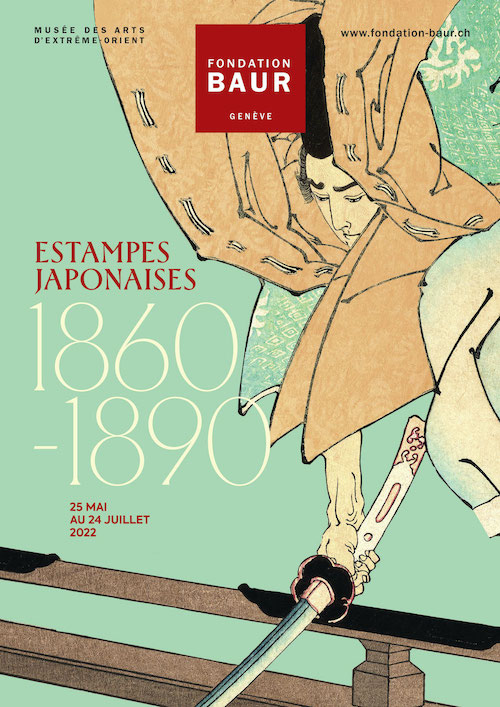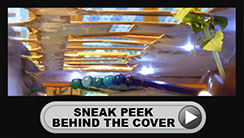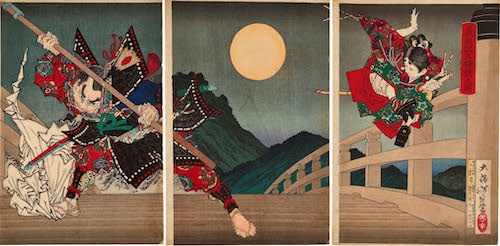
Tsukioka Yoshitoshi 月岡芳年 (1839-1892)
Illustration du pont Gojô de la Chronique de Yoshitsune, 1881
Fondation Baur, FB.DFC.2019.9 © Fondation Baur, photo Marian Gérard
The Fondation Baur exhibit on Japanese prints take place from 25 May through 24 July 2022 in Geneva. Make sure you try to pass by and see this exceptional showing of rare items.
This exhibition presents, through three distinct themes, a glimpse of the enormous diversity of subjects and styles that characterize Japanese printmaking in the second half of the 19th century. All of these works were produced between 1860 and 1890, three decades corresponding to the last years of the Edo period 江戸 (1603-1868) and the beginning of the Meiji era 明治 (1868-1912), a crucial period in the history of modern Japan that saw profound political and societal changes brought about, among other things, by the opening of the country to ideas and technologies from the West. The first part of the exhibition, the so-called "Yokohama images" (Yokohama-e 横浜絵), illustrates the initial phase of this exchange, that of the encounter with Westerners, marked above all by curiosity.
The second part, the hashika-e 麻疹絵 ("measles pictures") reflects the hopes and fears felt by the population in the face of a deadly epidemic in 1862. The exhibition concludes with a presentation of the great draftsman Tsukioka Yoshitoshi 月岡芳年 (1839-1892), whose professional career took place precisely between 1863 and 1892: deeply attached to the history and values of his country, he was also an innovative and creative artist.
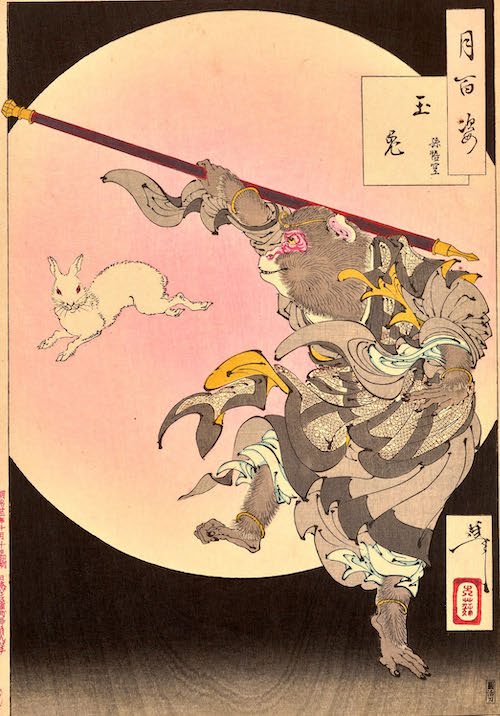
Tsukioka Yoshitoshi 月岡芳年 (1839-1892)
Lapin de Jade – Sun Wukong
de la série « Les Cent aspects de la lune » 1889
Fondation Baur, FB.DFC.2019.19 © Fondation Baur, photo Marian Gérard
The artists in this exhibition are all from the prestigious Utagawa School 歌川 and represent the generation of students of Hiroshige 広重 (1797-1858), Kunisada 國貞 (1786-1865) and Kuniyoshi 國芳 (1798-1861). Because of their apprenticeship in the studio, they were trained in a very wide range of subjects, portraits of actors or women, landscapes, war subjects or other cartoons. The same artists' signatures can be found on the Yokohama-e and the hashika-e, all of them fellow students of Yoshitoshi who also contributed some compositions to these categories.
These prints, the majority of which have never before been exhibited at the Baur Foundation, come from the Ida Votsch donation (1990) in the case of the measles prints, the Hughes Fontanet collection (2016) for the Yokohama images, and the Cigarini donation (2019) for the Tsukioka Yoshitoshi works. May all these people be once again warmly thanked here for their generosity.
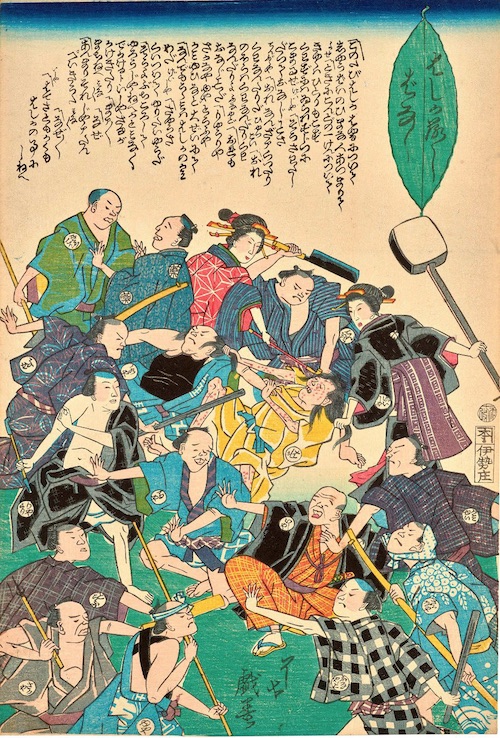
Sôsai Ryôko 叟斎了古 (actif 1860-1870)
Histoire comique sur la rougeole, 1862
Fondation Baur, FB.DIV.1990.39 © Fondation Baur, photo Marian Gérard
Japanese historical documents attest to the appearance of smallpox (hôsô 痘瘡) and measles (hashika 麻疹) epidemics as early as the 6th or 7th century. Brought on by maritime contacts with the Eurasian continent, these epidemics continued episodically throughout Japanese history, increasing dramatically from the early 17th century with the urban densification of the Edo period (1603-1868). Thirteen measles epidemics were recorded between 1607 and 1868, the most deadly being the one of 1862 which claimed nearly 240,000 victims in Edo city alone (now Tokyo). It was on this occasion that the first prints dedicated to this disease appeared, called hashika-e 麻疹絵 or "measles pictures".
Images associated with a particular, transient event such as an earthquake or epidemic were not intended to be kept for long. Acting as protective talismans, they were displayed on doors or walls of houses and were intended to help, if not to ward off disease, at least to protect against the most serious consequences of an infection. Aimed at a very wide audience and produced at a lower cost, in quick runs and in large quantities, they did not benefit from any of the special treatments - mica chips, subtle gradations, embossing or black overprints - that characterize very high quality prints.
Fondation Baur
Musée des arts d'éxtrême-orient
8, rue Munier-Romilly
1206 Genève
022 704 32 82
http://fondation-baur.ch
25 May through 24 July 2022
Open Tuesday to Sunday from 14h-18h (Monday closed), until 20h during public guided tours (see below)
Entrance fees (full price) : CHF 15.-
AHV, IV and students : CHF 10.-
Public guided tours: at 18h30 on Wednesdays
1, 15 and 29 June 2022
6 July 2022
by reservation This email address is being protected from spambots. You need JavaScript enabled to view it.




